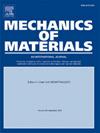The dual phase lag model for thermoelastic microbeams embedded in an elastic foundation incorporating fractional Kelvin–Voigt viscoelasticity
IF 3.4
3区 材料科学
Q2 MATERIALS SCIENCE, MULTIDISCIPLINARY
引用次数: 0
Abstract
This research presents the dual-phase lag model (DPL) for thermoelastic microbeams. The model, supported by Winkler foundations, incorporates fractional Kelvin–Voigt viscoelasticity. The model addresses the complexities of heat transfer and mechanical behavior in micro-scale structures by accounting for phase lags in both temperature and heat flux, which are crucial for accurate predictions at small scales. By integrating fractional Kelvin–Voigt viscoelasticity, the study improves the comprehension of time-dependent material responses, capturing the unique behaviors of viscoelastic materials at the micro-level. The governing equations combine the dual-phase lag mechanism with Winkler foundation assumptions for a comprehensive analysis of thermoelastic behavior. Advanced mathematical techniques, including the Laplace transform, are applied to derive expressions for key parameters such as temperature distribution, deflection, and stress profiles. Numerical simulations provide graphical representations that evaluate the effects of factors like fractional order, foundation stiffness, and viscoelastic properties on microbeam behavior. This model is a valuable tool for engineers and researchers designing advanced materials and structures for dynamic thermal and mechanical conditions, promoting innovation in nanotechnology, materials science, and structural engineering.
结合分数Kelvin-Voigt粘弹性的热弹性微梁嵌入弹性地基的双相位滞后模型
本文研究了热弹性微梁的双相位滞后模型。该模型由Winkler基础支持,包含分数开尔文- voigt粘弹性。该模型通过考虑温度和热流的相位滞后,解决了微尺度结构中传热和力学行为的复杂性,这对于在小尺度上进行准确预测至关重要。通过积分分数Kelvin-Voigt粘弹性,该研究提高了对随时间变化的材料响应的理解,在微观层面捕捉粘弹性材料的独特行为。控制方程结合了双相滞后机制和Winkler基础假设,对热弹性行为进行了综合分析。先进的数学技术,包括拉普拉斯变换,被应用于推导关键参数的表达式,如温度分布、挠度和应力分布。数值模拟提供了评估分数阶、基础刚度和粘弹性等因素对微梁行为的影响的图形表示。该模型是工程师和研究人员在动态热力学条件下设计先进材料和结构的宝贵工具,促进了纳米技术、材料科学和结构工程的创新。
本文章由计算机程序翻译,如有差异,请以英文原文为准。
求助全文
约1分钟内获得全文
求助全文
来源期刊

Mechanics of Materials
工程技术-材料科学:综合
CiteScore
7.60
自引率
5.10%
发文量
243
审稿时长
46 days
期刊介绍:
Mechanics of Materials is a forum for original scientific research on the flow, fracture, and general constitutive behavior of geophysical, geotechnical and technological materials, with balanced coverage of advanced technological and natural materials, with balanced coverage of theoretical, experimental, and field investigations. Of special concern are macroscopic predictions based on microscopic models, identification of microscopic structures from limited overall macroscopic data, experimental and field results that lead to fundamental understanding of the behavior of materials, and coordinated experimental and analytical investigations that culminate in theories with predictive quality.
 求助内容:
求助内容: 应助结果提醒方式:
应助结果提醒方式:


